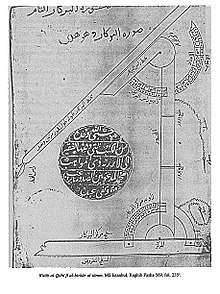Abu al-Jud
Abū al-Jūd, Muḥammad b. Aḥmad b. al-Layth was an Iranian mathematician. He lived during 10th century and was a contemporary of Al-Biruni. Not much is known about his life. He seems to have lived in the east of Khurasan, within Samanid territory. Sa'id al-Andalusi claimed that he lived in Valencia (Balansiya) and died in 1014 or 1015, but other sources didn't mention these information. It is likely that he became a scribe after acquiring basic knowledge on mathematics.[1]
In the 10th century, Abu al-Jud used conics to solve quartic and cubic equations, a century before the more famous work of Omar Khayyam.[2]
References
- ↑ Ali, Mowlavi, Muhammad; Rahim, Gholami,. "Abū al-Jūd". Encyclopaedia Islamica. Encyclopaedia Islamica. doi:10.1163/1875-9831_isla_com_0092. Retrieved 27 February 2017.
- ↑ Sidoli, Nathan; Brummelen, Glen Van (2013-10-30). From Alexandria, Through Baghdad: Surveys and Studies in the Ancient Greek and Medieval Islamic Mathematical Sciences in Honor of J.L. Berggren. Springer Science & Business Media. p. 110. ISBN 978-3-642-36736-6.
This article is issued from
Wikipedia.
The text is licensed under Creative Commons - Attribution - Sharealike.
Additional terms may apply for the media files.
